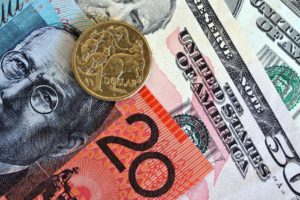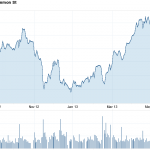 Australian dollar traded lower against its US counterpart on Thursday on speculation that US non-farm payrolls report on Friday may urge the Federal Reserve Bank to continue scaling back its monetary stimulus.
Australian dollar traded lower against its US counterpart on Thursday on speculation that US non-farm payrolls report on Friday may urge the Federal Reserve Bank to continue scaling back its monetary stimulus.
AUD/USD touched a session low at 0.8866 at 2:10 GMT, after which consolidation followed at 0.8878, falling 0.25% for the day. Support was likely to be received at January 2nd low, 0.8843, while resistance was to be met at January 8th high, 0.8952. The Australian dollar has depreciated 16% against the greenback during the past 12 months, or the largest drop after the Japanese yen among the group of ten developed-nation currencies.
Employers in the United States probably added 195 000 job positions in December, after jobs were boosted by 203 000 in November, according to the median estimate of economists participated in a survey by Bloomberg News. The official report on non-farm payrolls is to be released on Friday.
The US dollar received support yesterday after a report by the ADP research institute said that the US private sector added 238 000 jobs in December, the most since January 2012, exceeding analysts’ projections of 200 000 new jobs. In November 215 000 new job positions were added.
“While the ADP results are not always a reliable guide for payrolls, they nevertheless improve the chances of an above-consensus payrolls result on Friday night,” National Australia Bank Ltd. analysts led by head of market research Peter Jolly wrote in a research note, the same media reported.
Also yesterday, the Federal Reserve Bank released the minutes of its most recent policy meeting. “Many members judged that the Committee should proceed cautiously in taking its first action to reduce the pace of asset purchases and should indicate that further reductions would be undertaken in measured steps”, the minutes revealed.
“Members also stressed the need to underscore that the pace of asset purchases was not on a preset course and would remain contingent on the Committees outlook for the labor market and inflation as well as its assessment of the efficacy and costs of purchases.”
Meanwhile, the Australian Bureau of Statistics reported earlier on Thursday that nations retail sales rose 0.7% in November compared to a month ago, outstripping expectations of a 0.4% gain, after in October sales climbed 0.5%. November was the seventh consecutive month in which retail sales recorded gains, which came as another evidence that record low borrowing costs are causing a positive impact upon consumer spending in Australia. Overall results have been supported by sales at cafeterias and restaurants.
“Retail sales surprised to the upside yet again,” Su-Lin Ong, the head of Australian economic and fixed-income strategy at Royal Bank of Canada in Sydney, wrote in a note to clients, cited by Bloomberg. “The odds are that sales finished 2013 on a firm note.”
In addition, traders saw a 23% probability that the Reserve Bank of Australia (RBA) will reduce its benchmark interest rate by its policy meeting in June, according to swaps data. Yesterday the odds of such a move were 21%. The central bank has cut its benchmark eight times since late 2011 in order to support economy, especially the housing sector and retail trade, as investment boom in the sector of mining has waned. Mining has been the main driving force behind Australian economic growth during the past decade.
Elsewhere, the Aussie was lower against the euro, with EUR/AUD cross gaining 0.44% on a daily basis to trade at 1.5323 at 7:55 GMT. AUD/NZD pair was losing 0.21% to trade at 1.0753 at 7:56 GMT, after on December 18th it fell to 1.0733, the lowest level since October 2008.





